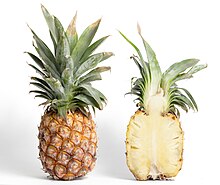
Multi-fruits, also called collective fruits, are fruiting bodies formed from a cluster of flowers, the inflorescence. Each flower in the inflorescence produces a fruit, but these mature into a single mass. After flowering, the mass is called an infructescence. Examples are the fig, pineapple, mulberry, osage orange, and jackfruit.
In contrast, an aggregate fruit such as a raspberry develops from multiple ovaries of a single flower. In languages other than English, the meanings of "multiple" and "aggregate" fruit are reversed, so that multiple fruits merge several pistils within a single flower.
In some cases, the infructescences are similar in appearance to simple fruits. One example is pineapple (Ananas), which is formed from the fusion of the berries with receptacle tissues and bracts.

As shown in the photograph of the noni, stages of flowering and fruit development in the noni or Indian mulberry (Morinda citrifolia) can be observed on a single branch. First an inflorescence of white flowers called a head is produced. After fertilization, each flower develops into a drupe, and as the drupes expand, they become connate (merge) into a multiple fleshy fruit called a syncarp. There are also many dry multiple fruits.
Other examples of multiple fruits:
- Plane tree, multiple achenes from multiple flowers, in a single fruit structure
- Mulberry, multiple flowers form one fruit
- Breadfruit, multiple flowers form one fruit
- Fig, multiple flowers similar to mulberry infructescence form a multiple fruit inside the inverted inflorescence. This form is called a syconium.
Gallery
See also
References
- Schlegel (2003-05-13). Encyclopedic Dictionary of Plant Breeding and Related Subjects. Taylor & Francis. p. 282. ISBN 9781560229506.
- Hickey, M.; King, C. (2001). The Cambridge Illustrated Glossary of Botanical Terms. Cambridge University Press.
- Beentje, H.; Williamson, J. (2010). The Kew Plant Glossary: an Illustrated Dictionary of Plant Terms. Royal Botanic Gardens, Kew: Kew Publishing.
- Spjut, R.; Thieret, J. (1989). "Confusion between multiple and aggregate fruits". The Botanical Review. 55 (1): 53–72. Bibcode:1989BotRv..55...53S. doi:10.1007/bf02868781. S2CID 24994626.
- "Multiple Fruits, Pineapple Multiple Fruit, Examples of Multiple Fruits, Types of Multiple Fruits". www.fruitsinfo.com. Retrieved 2022-03-18.
- "Multiple Fruits". science.jburroughs.org. Archived from the original on 2022-01-08. Retrieved 2022-03-18.
| Types of fruits | |
|---|---|
| Types of fruits | |
| Categories of fruits | |
| Function | |

